If you’re even remotely serious about building your skills with AI, you’ve probably heard about Genspark and Manus. These two AI agent platforms have gained a lot of attention, and for good reason: they take tasks that used to chew up hours and crush them down to minutes. Whether you’re looking to speed up your research, power through data analysis, build websites, or create interactive presentations and dashboards, these tools could be life-changers.
But here’s the real question: Which one should you choose?
In this blog post, I’ll walk you through the most comprehensive, no-hype, side-by-side comparison of Genspark vs Manus. We won’t just rattle off features. Instead, we’ll get hands-on and see how they stack up against each other across some of the most important real-world use cases: research, coding, data analysis, slide decks, dashboard building, and plenty more.
By the end, you’ll understand:
- Where each platform shines
- Where they fall short
- Which will fit your workflow, needs, and budget
Get ready for a deep dive. Let’s get started!
Table of Contents
How We’re Comparing Genspark and Manus
Before we get stuck into the details, here’s how we’ll be evaluating both platforms across all use cases:
- Credits Used: How many credits/tasks does it burn through?
- Time to Complete: Which one gets the job done faster?
- Output Quality & Accuracy: Does it actually solve your task properly?
- Visual Formatting & Interactivity: Do the results look sharp and work interactively?
These are the four areas that matter most when you’re actually building with AI daily.
We’ll dig into each use case, show you how much each tool uses (credits and time), compare outputs, and break down all the key differences. We’ll even provide screenshots and visuals to help you see what’s happening.
Let’s kick off with the basics.
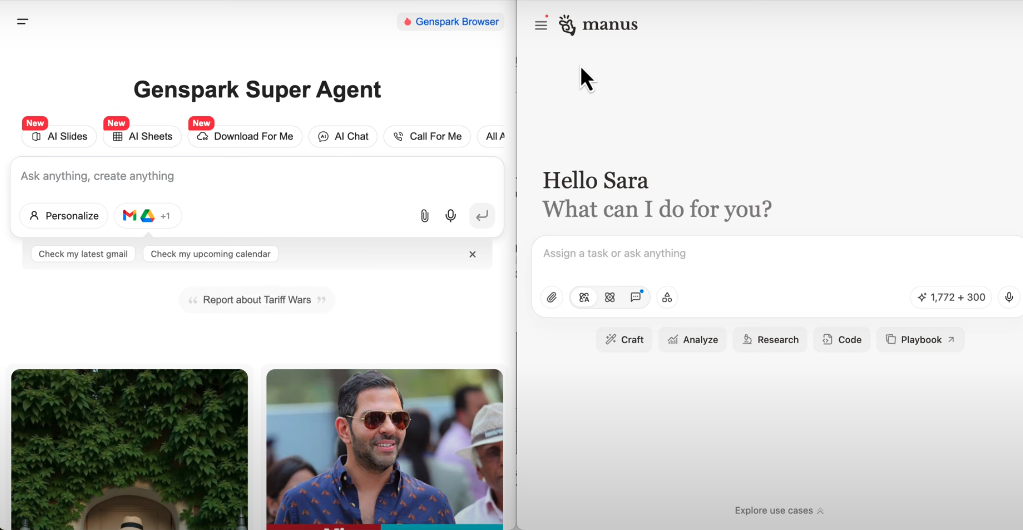
Credit Systems: Genspark vs Manus
Both Genspark and Manus are free to start with, but their credit systems are a little different.
Genspark:
- 200 credits per day, renewed every 24 hours
Manus:
- 300 credits per day, renewed every 24 hours
- PLUS a one-time bonus of 1,000 free credits when you start
| Credit Comparison: GenSpark AI vs Manus AI | ||
|---|---|---|
| GenSpark AI | Manus AI | |
| Free to Start | Yes | Yes |
| Initial Free Credits | None | 1,000 credits upfront |
| Daily Free Credits | 200 credits/day | 300 credits/day |
| When Do Credits Refresh? | Every 24 hours | Every 24 hours |
On paper, Manus gives you a bigger lump sum and higher daily cap… but, what really matters is how many credits each uses for the same real-world task. One might burn through credits faster than the other.
So—do you get more bang for your buck with Genspark’s efficiency, or is Manus’ up-front allocation a true advantage?
We’ll answer with real data as we put them through their paces.
Use Case Showdown: Head-to-Head Tests
Let’s get into the high-impact use cases, using the exact same prompts and datasets in each tool.
For each test, I’ll show:
- A breakdown of the prompt/task
- Completed outputs (with images/screenshots)
- Credit and time comparisons
- A review of output quality and interactivity
1. Creating Interactive Presentations
Task:
Build a four-slide interactive presentation on “How small business can use AI to boost efficiency and profitability.” Should include key stats, recent trends, and be suitable for a business audience.
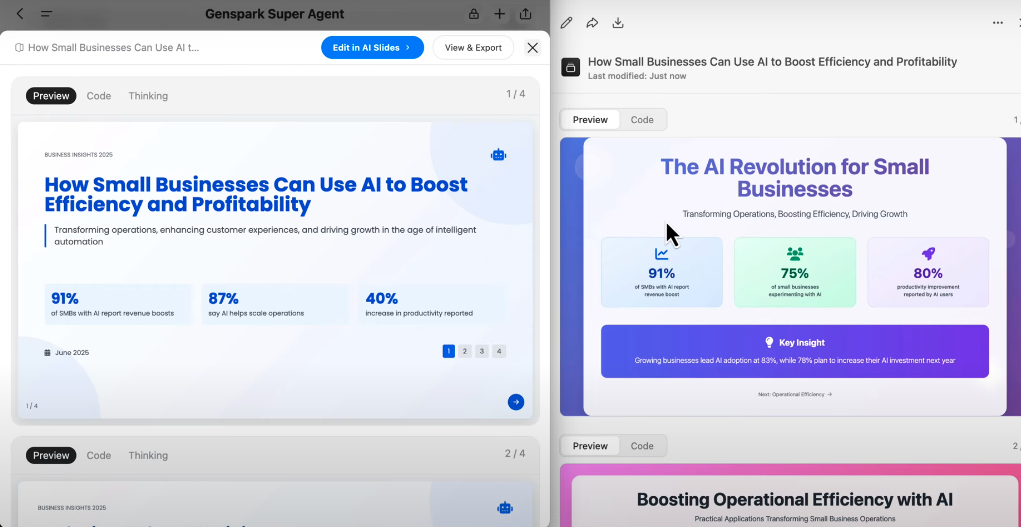
Performance Comparison Table: GenSpark vs Manus
| Test | Evaluation Criteria | GenSpark | Manus |
|---|---|---|---|
| Test 1: Generate a 4-slide interactive presentation | Credits Used | Start 8942 End 8843 99 credits | 86 credits |
| Time to Complete | 6 min | 10 min | |
| Output Quality & Accuracy | ✔ | ✔ | |
| Visual Formatting & Interactivity | More Professional | Too colourful |
Output & Formatting Comparison
Both platforms used trustworthy stats and multiple sources, but Genspark’s slides felt more polished and practical for a real-deal business setting.
“I like the way [Genspark] integrated those graphs with different tables and boxes… more professional-looking.”
Verdict:
Genspark wins on speed, visual style, and interactivity, though Manus burned a few less credits.
2. Data Analysis and Visualization
Task:
As a research data analyst, analyze a provided dataset to identify correlations between exercise duration and stress. Generate at least two visualizations (scatter and line), calculate correlations, explain findings, and write a discussion suitable for a professional report.
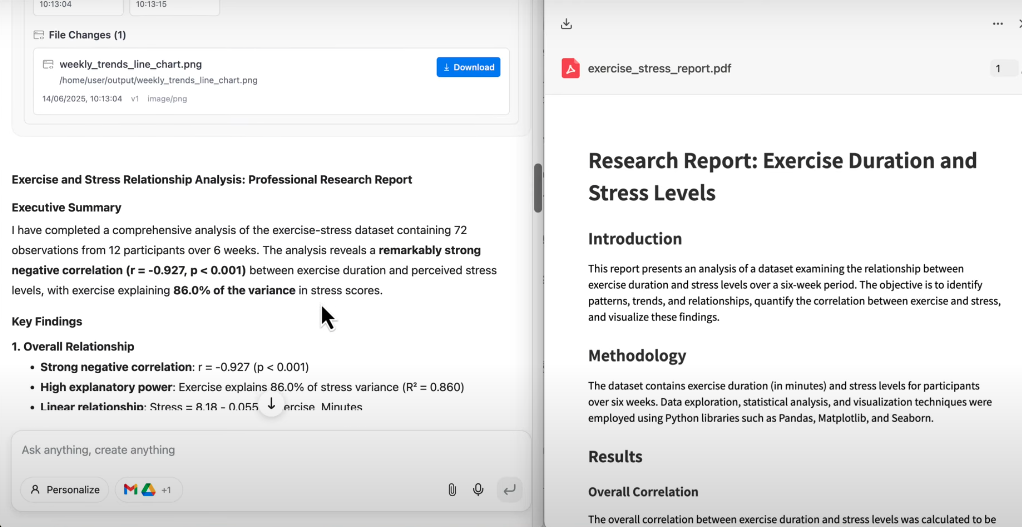
| Test | Evaluation Criteria | GenSpark | Manus |
|---|---|---|---|
| Test 2: Data Analysis | Credits Used | 33 credits | 84 credits |
| Time to Complete | 7 minutes | 7 minutes | |
| Output Quality & Accuracy | 1 | ||
| Visual Formatting & Interactivity | 1 |
Output & Formatting Comparison
- Genspark: Good output, more “blocks” of info.
- Manus: More like a proper academic or business report. Attachments make it simple to reuse the content.
“Even though Genspark has gathered the correct information, just the way that it’s being presented here on Manus is something I would prefer — it’s just a lot easier to read.”
Verdict:
For detailed analysis, structure, and multi-format outputs, Manus takes the crown (though it uses more credits).
3. Website Creation for a YouTube Channel
Task:
Research my AI and Tech for Education YouTube channel, then build and deploy a clean, informative, responsive one-page site as an official channel homepage. Must pull in content categories, sample videos, features, newsletter section, and contact/collaborate/social links.
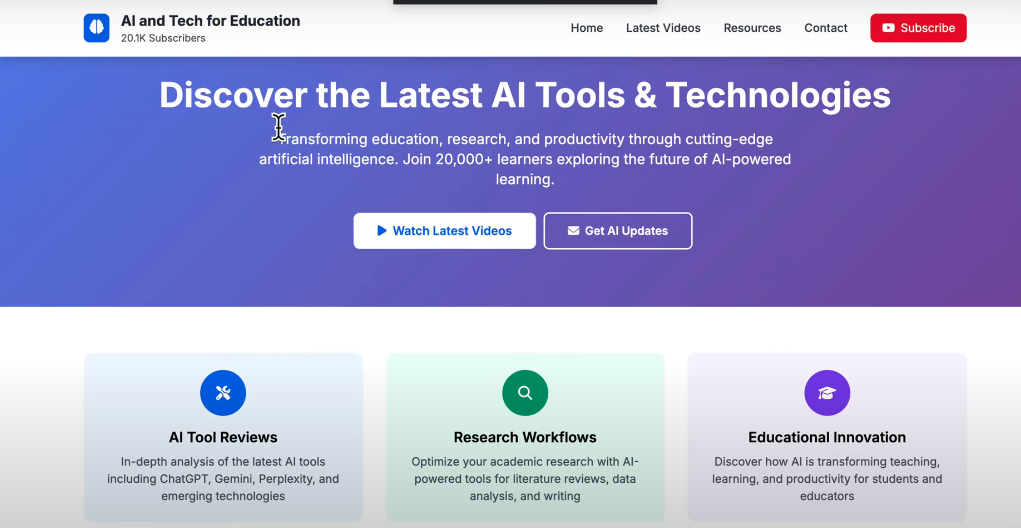
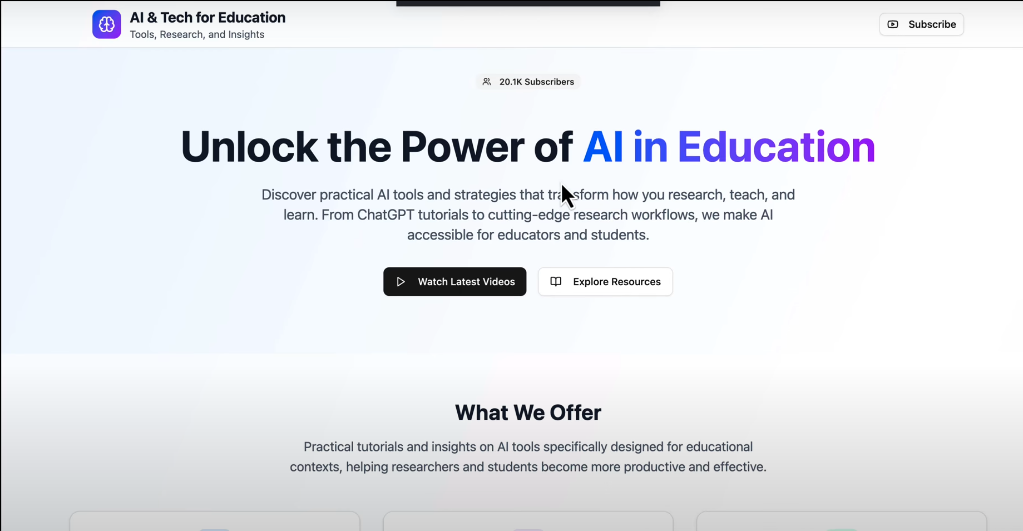
| Test | Evaluation Criteria | GenSpark | Manus |
|---|---|---|---|
| Test 3: Channel Research and Website Development | Credits Used | 275 credits | 1305 credits |
| Time to Complete | 12 minutes | 45 minutes | |
| Output Quality & Accuracy | Good quality Mostly working buttons | Not all buttons working | |
| Visual Formatting & Interactivity | Professional Interactive design | Good layout but could have been more creative with colours |
Output & Formatting Comparison
Genspark nails the look, feature set, and interactivity out of the box. Manus’ site is passable, but lacks interactive video embeds and the critical polish you’d expect for production.
“Genspark here did a much better job… Took much less time, used a fraction of the credits, and gave a better result.”
Verdict:
For rapid website buildouts (especially with embedded video and working features), Genspark wins hands-down.
4. Designing a Modern App Poster
Task:
Create a minimalist poster for an AI-powered note-taking app called “Notewise.” Needs to show a digital app interface next to messy handwritten notes, add the tagline “Take notes the smart way”, use digital-friendly colors, and feature App Store/Google Play download buttons.
| Test | Evaluation Criteria | GenSpark | Manus |
|---|---|---|---|
| Test: Create a visual poster | Credits Used | 21 credits | 32 credits |
| Time to Complete | 3 minutes | 12 minutes | |
| Output Quality & Accuracy | Followed all instructions with name of the app and app store buttons | Followed all instructions with name of the app and app store buttons | |
| Visual Formatting & Interactivity | Nice looking design | Nice looking design |
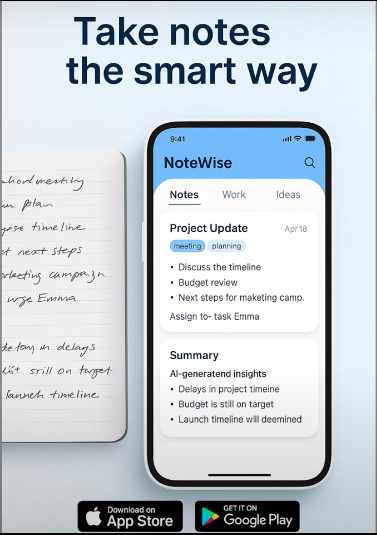
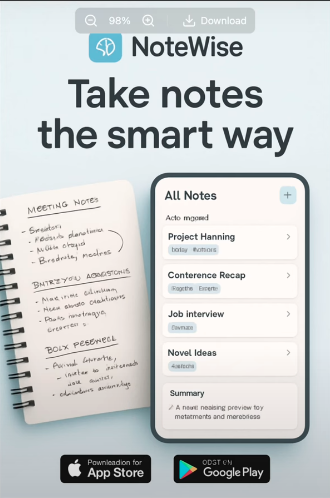
Output & Formatting Comparison
Let’s be real: Both platforms clearly used a similar backend AI image generator. The outputs look almost identical, and both did a truly solid job.
Verdict:
Tied for output quality, but Genspark is faster and more efficient with credits.
5. Building an Interactive AI Startup Dashboard
Task:
Create an interactive dashboard to track/compare AI startups in Europe. Must include region, type, funding stage, year filters, show total funding, model types, and more. Visualizations for funding by country, top startups, founded year, and so on. Output should be visually stunning and interactive.
| Test | Evaluation Criteria | GenSpark | Manus |
|---|---|---|---|
| Test: research then create an interactive dashboard | Credits Used | 330 credits | 654 credits |
| Time to Complete | 13 minutes | 15 minutes | |
| Output Quality & Accuracy | Accurate and followed instructions | Accurate and followed instructions | |
| Visual Formatting & Interactivity | Slightly more visually interactive | Interactive and visually appealing |
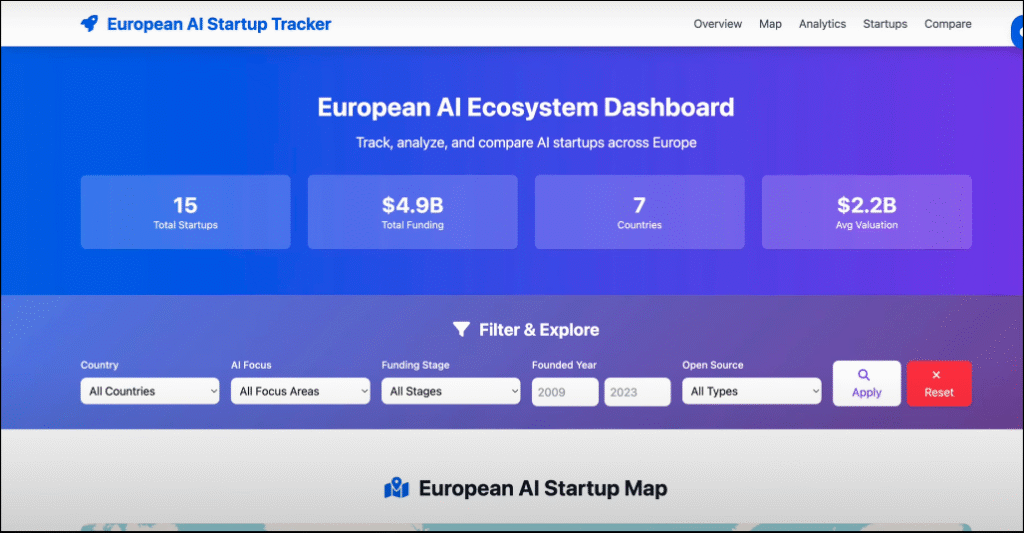

Output & Formatting Comparison
Both platforms delivered the nuts and bolts, but Genspark’s use of interactive maps and engaging design edges ahead. Plus, it gets it done using about half the credits.
“I like the interactive map that we’ve been given; the analytics and insights, and the way it’s been generated… much better looking dashboard.”
Verdict:
For dashboards that look as good as they work, Genspark is the go-to.
Comparison Table: Genspark vs Manus
| Use Case | Genspark (Credits/Tim) | Manus (Credits/Tim) | Output Quality | Visual Formatting & Features | Winner |
|---|---|---|---|---|---|
| Presentation | ~200 credits free daily; builds decks in ~5–10 min | ~39–199 $/mo; decks take ~30+ min | Genspark: crisp, modern Manus: fine but generic | Genspark: polished and coherent; Manus: more template-like | Genspark |
| Data Analysis | Fast breakdown and visuals via 9-model engine | Great at developer/data-heavy tasks | Manus edges in technical depth; Genspark more generalist | Genspark: good visuals; Manus: structured, technical analytics | Manus |
| Website Creation | ~15–20 min builds; deploys real sites, real images | Slower, basic site output with stock visuals | Genspark: highly polished | Genspark: working nav, real photos; Manus: basic function | Genspark |
| App Poster | Built in 5–10 min | ~30+ min | Comparable | Genspark: sleek; Manus: serviceable | Genspark |
| Dashboard | Fast dashboards via multi-agent tools | Strong in code-driven dashboards | Genspark: good; Manus: detailed layouts | Genspark: better visuals; Manus: structured analytics | Draw |
“Across the different tasks, Genspark performs more efficiently and produces better visual output across most cases, even though Manus digs deeper with sources and uses more credits.”
Key Takeaways: Which Should You Choose?
After putting both platforms through a string of tough, realistic tests, here’s what stands out:
Genspark
- Best for: Anyone who needs faster results, high-impact visuals, and solid interactive elements (presentations, dashboards, posters, websites).
- Credit use: Consistently more efficient.
- Interactivity: Richer and easier to tweak live.
- When not optimal: If you need massively detailed, step-by-step research output (think academic or enterprise-grade reports).
Manus
- Best for: Deep-dive users who want documented, highly structured outputs, and who value research transparency (think: data analysis, academic submissions, multi-file reports).
- Credit use: Uses more credits on most tasks.
- Output Style: More attachments, PDFs, separate chart files, direct download for use in workflows.
- When not optimal: If you need quick, highly visual or interactive outputs for demos, clients, or time-pressed tasks.
Your Experience and Next Steps
Everyone’s workflow and needs are a little different. If you’re a visual, rapid-move builder, Genspark is probably your best friend. If you’re a meticulous data wrangler or corporate researcher, Manus might give you that bit of extra edge with “export everything” options and deeply structured results.
Try both! Both offer generous free tiers to get started. Test them on your own tasks, see which output style suits you, and weigh those credit uses if you’re building at scale.
“Let me know what your experience has been in using both of these AI agents — and if you’d like to see any other areas covered in future comparisons.”
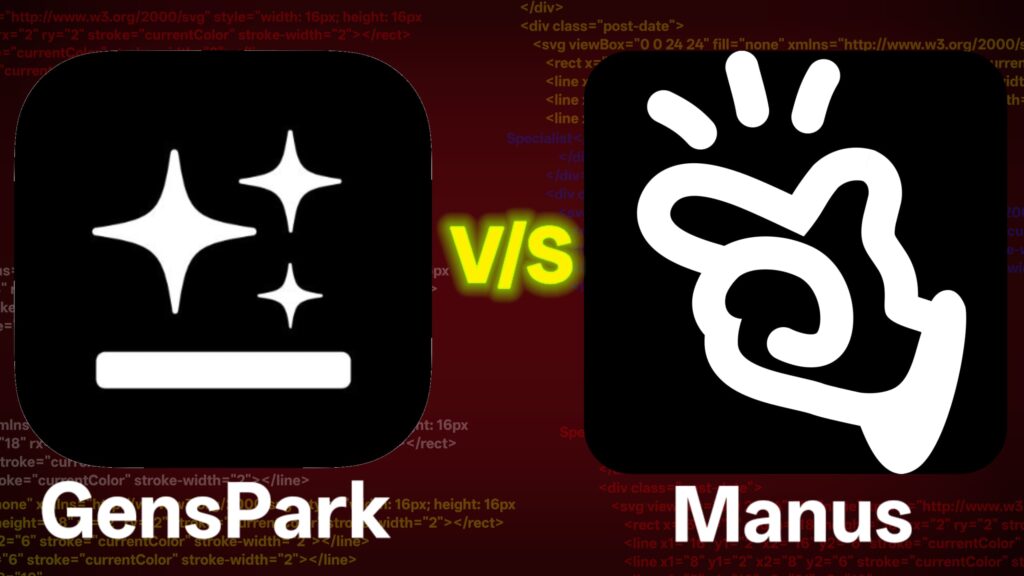
Quick FAQ
Can I switch between them for different tasks?
Yes! In fact, it’s a smart move: use Genspark for visual-heavy outputs, and Manus for dense, research-centric reports.
Are there hidden costs?
Mainly, you’re managing your credit usage. Once you burn through the free credits, both offer paid upgrades. Watch credit costs for big data analysis or website generation on Manus.
How do they handle source authority and fact-checks?
Both pull research from multiple sources. Genspark offers quicker live fact-check integration; Manus excels at providing attachments and detailed breakdowns.
Conclusion: Which One Deserves Your Credits?
There’s no one-size-fits-all answer — but you now have a clear, detailed sense of where each platform excels.
- Want speed, stunning visuals, and interactive demos? Start with Genspark.
- Need deep analysis, structured output files, and robust data exports? Lean on Manus.
Whichever you choose, you’ll be leveling up your AI-powered workflow and saving hours on things that used to eat up your week.
Happy building! And don’t forget to drop your own results and favorite use cases in the comments.
